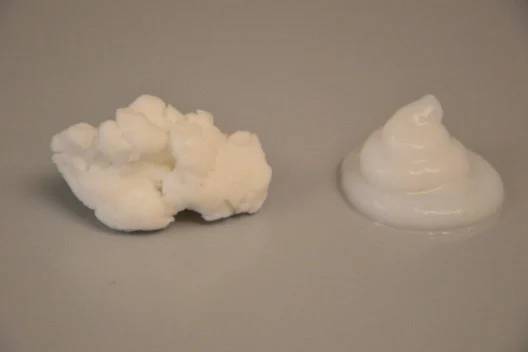
Why readily activated microfibrillated cellulose makes life easier
Anni Karppinen | June 21, 2016
Microfibrillated cellulose (MFC) has potential as a multifunctional additive in various applications. Its performance ranges from improving stability and flow properties in coatings and adhesives to giving immediate anti-wrinkle effect in skin creams. We often say that, in addition to these effects, one of the other advantages of using MFC is that it is “readily activated”. But what does that mean?
MFC does not need swelling time
Some of the additives commonly used for controlling rheology need to be swelled in water before they can be added to the formulation. For example, different clays used in coatings, or cellulose derivatives used in cosmetic products, need this kind of pre-activation.
MFC, on the other hand, is normally delivered as a suspension or paste in water, and no swelling time is required in order to activate it. It can be dispersed directly into the formulations without any pre-swelling .
It is still important to remember that you need to disperse the MFC properly into your formulation, as described more closely in “Dispersion of microfibrillated cellulose – a critical success factor”.

MFC is normally delivered as a suspension in water, which means that it does not need swelling time. This picture shows 10 % and 2 % Exilva MFC suspensions from Borregaard.
MFC does not need a certain pH to be activated
MFC consists of a three dimensional network of cellulose microfibrils, where the microfibrils are mainly connected via physical entanglements. It is this interaction between the microfibrils and the network that result in many of the special properties of the MFC. These physical interactions are not dependent on the pH, and therefore MFC is stable over the whole pH range and can also be added and dispersed into the formulation at any pH level.

The pH of MFC suspension is naturally close to neutral, but it can be used in basic and acidic formulations.
MFC is not dependent on heat to be activated
For some rheology modifiers and additives heat can be required in order to activate or dissolve them. For MFC, on the other hand, no heat or a certain temperature is needed, and it can be dispersed directly into the formulations at room temperature. However, the MFC network is stable against temperature in the same way as it is stable against pH. This means that it can be dispersed at higher temperatures if needed.
How can this benefit your process?
No swelling time can be beneficial with regards to shorter processing time and flexibility in the process. If the additive has to swell, for some additives even overnight, this increases production time, of course, and might put pressure on tank or reactor capacity.
The fact that MFC does not need any specific pH or temperature level to be activated increases the flexibility of the process design. In addition, it saves both energy and time since adjustment of the pH or temperature level is not required before adding the material. Furthermore, it gives you the opportunity to add the rheology additive where it is most beneficial, independent of the pH or temperature level.
So this is what we mean when we say that MFC is “readily activated”. Something to consider if your current additives need long swelling times and specific pH and temperature levels?
Written by:
Anni Karppinen
